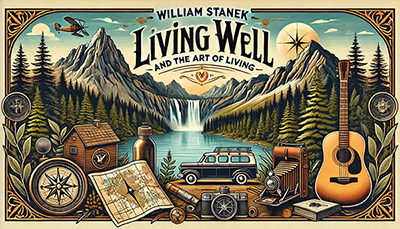

Spotlight on Life's Milestones
Life’s defining moments shape who we are and the paths we take. In this series, William and Hui Cha Stanek invite you to reflect on pivotal milestones, celebrating the journey and the lessons learned along the way.

Transform your life with practical wisdom. Discover William Stanek's 'Living Well' series—your guide to a balanced and fulfilling life.
Discover William Stanek's Exclusive Art Collection
Explore and purchase the stunning art featured on this site. Own a piece of William Stanek's unique and captivating artwork today!
(April 25, 2025) Rites of Passage: Cultural and Personal Milestones
Rites of passage are deeply rooted in the human experience, serving as powerful markers of life’s most significant transitions. Across different cultures and throughout history, these ceremonies have honored moments of change—whether it’s the transition from childhood to adulthood, the joining of two lives in marriage, or the passage from life to death. Rites of passage are not just rituals; they are profound experiences that shape our identities, connect us to our communities, and help us navigate the complexities of personal growth. In this article, we’ll explore the significance of rites of passage, both cultural and personal, and how these milestones contribute to our understanding of who we are and where we belong.
The Cultural Significance of Rites of Passage: Connecting Tradition and Identity
Rites of passage are a fundamental aspect of cultural tradition, reflecting the values, beliefs, and social structures of the communities that practice them. These ceremonies mark important life transitions, providing individuals with a sense of belonging and continuity within their culture. Whether it’s a coming-of-age ceremony, a wedding, or a funeral, rites of passage serve to guide individuals through the key stages of life, offering both personal and communal meaning.
In many cultures, rites of passage are carefully structured and steeped in symbolism. They often involve rituals, ceremonies, and celebrations that have been passed down through generations, each element carrying deep cultural significance. These rites not only honor the individual’s transition but also reinforce the cultural values and social bonds that hold the community together.
For me, one of the most profound cultural rites of passage I experienced was my marriage to Hui Cha. Our wedding ceremony was a blend of traditions, reflecting both our cultural backgrounds and our personal values. We incorporated elements from Korean culture, honoring Hui Cha’s heritage, while also including traditions from my own cultural background. This fusion of traditions created a ceremony that was not only a celebration of our love but also a reflection of our identities and the communities that shaped us.
The wedding was more than just a personal milestone; it was a rite of passage that marked our transition from individuals to a married couple, united in our commitment to each other and to the life we were building together. The ceremony connected us to our families, our cultures, and our shared future, providing a foundation of meaning and purpose as we embarked on our journey together.
Personal Milestones as Rites of Passage: The Power of Individual Growth
While cultural rites of passage are often communal events, personal milestones can also serve as powerful rites of passage in their own right. These moments of individual growth—such as graduating from school, starting a new career, or overcoming a significant challenge—are milestones that mark our personal development and transformation. They are the moments when we step into a new phase of life, often with a renewed sense of identity and purpose.
One of the most significant personal rites of passage in my life was the decision to leave my military career and pursue a creative path. This decision marked a major turning point, not just in my professional life but in my identity as a whole. The military had been a central part of my life for many years, providing structure, purpose, and a sense of belonging. Leaving that behind was both liberating and daunting—a rite of passage that required me to redefine who I was and what I wanted to achieve.
This personal milestone was not marked by a formal ceremony, but it was no less significant. It was a moment of profound personal growth, one that challenged me to step out of my comfort zone, to embrace uncertainty, and to trust in my ability to create a new path for myself. It was a rite of passage that allowed me to explore my creativity, to express my true self, and to build a career that was aligned with my values and passions.
Personal milestones like this one are powerful because they represent the culmination of our efforts, the realization of our potential, and the beginning of a new chapter in our lives. They are moments that shape our identity, influence our choices, and contribute to our ongoing journey of personal growth.
The Intersection of Cultural and Personal Rites of Passage: A Fusion of Tradition and Individuality
In many cases, cultural and personal rites of passage intersect, creating a unique blend of tradition and individuality. These moments allow us to honor the cultural practices that have shaped us while also expressing our personal identity and values. This fusion of cultural and personal milestones is a powerful way to connect with our heritage while also embracing our individuality.
For Hui Cha and me, this intersection was particularly evident in the way we raised our children. We wanted to ensure that our children were connected to their cultural heritage, so we incorporated elements of Korean tradition into their upbringing. This included celebrating key milestones in their lives with traditional Korean ceremonies, such as the first birthday celebration, known as “Dol,” which is a significant rite of passage in Korean culture.
At the same time, we also wanted our children to develop their own identities, so we encouraged them to explore their interests, to express themselves freely, and to make their own choices. This blend of tradition and individuality allowed our children to feel connected to their heritage while also growing into their own unique selves.
Another example of this intersection is how we’ve approached significant life events, such as funerals. In both our families, traditional funeral rites are deeply respected and carefully observed. These rites provide a sense of closure, honor the life of the deceased, and connect the living to their ancestors. When we lost loved ones, we observed these traditional rites, but we also added personal touches that reflected our individual relationships with the deceased. This blend of cultural tradition and personal expression allowed us to honor both the past and the present, creating a meaningful and personalized rite of passage.
The Role of Rites of Passage in Personal Growth: Navigating Life’s Transitions
Rites of passage play a crucial role in personal growth, helping us navigate life’s transitions with a sense of purpose and direction. Whether these rites are culturally prescribed or personally defined, they provide us with a framework for understanding and processing the changes we experience. They offer us the opportunity to reflect on our journey, to acknowledge our growth, and to set intentions for the future.
One of the most challenging rites of passage I’ve faced was the transition from middle age into the later stages of life. This period of life is often accompanied by a range of emotions—from a sense of loss as we say goodbye to youth, to a growing appreciation for the wisdom and perspective that comes with age. Navigating this transition required me to confront my own fears about aging, to let go of certain aspects of my identity, and to embrace the new opportunities that this stage of life offers.
This rite of passage was marked by a deepening of my spiritual and creative practices. As I’ve grown older, I’ve found myself drawn to exploring themes of time, memory, and the human experience in my writing and photography. This creative exploration has allowed me to process my own experiences of aging, to connect with others who are going through similar transitions, and to find meaning and purpose in this new chapter of life.
Personal growth is often marked by these rites of passage, which serve as milestones in our journey of self-discovery. They challenge us to confront our fears, to embrace change, and to step into new roles and responsibilities. By recognizing and honoring these moments, we can navigate life’s transitions with greater clarity, confidence, and a sense of purpose.
A Call to Action: Honor Your Rites of Passage
Rites of passage, whether cultural or personal, are powerful milestones that mark the significant transitions in our lives. By honoring these moments with intention and reflection, we can navigate life’s changes with grace, deepen our understanding of ourselves, and strengthen our connection to our heritage and community.
Here are a few steps you can take to honor your rites of passage:
-
Reflect on Your Cultural Traditions: Take time to explore the cultural rites of passage that have shaped your heritage. How do these traditions influence your identity? How can you honor them in your own life?
-
Acknowledge Your Personal Milestones: Recognize the personal milestones that have marked your growth and transformation. Celebrate these moments as rites of passage that contribute to your ongoing journey of self-discovery.
-
Create Your Own Rites of Passage: If you find yourself at a significant transition in life, consider creating your own rite of passage. This could be a personal ceremony, a creative project, or a symbolic act that marks the transition and sets intentions for the future.
-
Blend Tradition and Individuality: Find ways to incorporate your cultural traditions into your personal milestones, while also expressing your individuality. This fusion of tradition and personal expression can create a meaningful and unique rite of passage.
-
Share Your Rites of Passage with Others: Rites of passage are often communal events, providing an opportunity to connect with others and to share your journey. Whether it’s through a formal ceremony or a simple conversation, share your experiences with those you trust and respect.
-
Embrace the Growth That Comes with Change: Rites of passage are moments of transformation that challenge us to grow and evolve. Embrace the changes that come with these transitions, and use them as opportunities for personal growth and self-discovery.
Your rites of passage are significant milestones in your life’s journey, offering you the opportunity to connect with your heritage, to celebrate your growth, and to navigate life’s transitions with purpose and intention. By honoring these moments, you can deepen your understanding of who you are, strengthen your connection to your community, and continue on your journey of living well.
Embrace your rites of passage, honor your traditions, and continue on your path of personal growth and discovery.

Join William at the crossroads of technology, business, and leadership, where true influence isn't about titles - it's about inspiring action, driving change, and guiding others with integrity. Discover how authentic leadership can transform not just careers, but entire industries.
Bring Inspiration Home
Enhance your space with William Stanek's evocative art. Each piece is crafted to inspire and uplift your everyday life.

Support The Lights of Paris by Robert Stanek, William Stanek's pen name! Through vivid historical detail and deeply moving character stories, Robert takes readers on an unforgettable journey through one of history’s most transformative times.

















